Neptune's Dark Spots and
Their Disappearance Act
By: Erika Hritzuk, Kamryn Klassen, Fatma Sonaallah, and Hind Ali
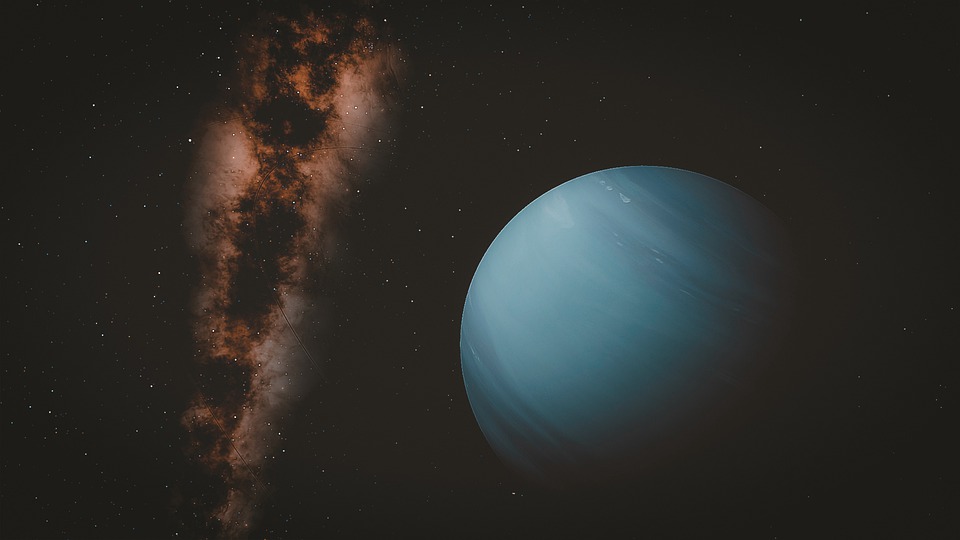
https://pixabay.com/illustrations/neptune-space-planet-universe-4654560/
Neptune’s Great Dark Spot is a feature on Neptune’s surface that was discovered in 1989 when Voyager 2 spacecraft flew by Neptune on its mission to study other outer planets. When the Hubble Space Telescope observed Neptune in 1994, the giant dark spot had disappeared while other spots had appeared in the northern atmosphere.¹ The motivation behind the study of Neptune's Great Dark Spots is because it is a subject that is not well known in the astronomic world today due to being overshadowed by Jupiter’s Great Red Spot. Neptune and its spots are unique to outer space because of how it was discovered and keeps disappearing when further observed. The discovery of Neptune’s Great Dark Spot is a more recent discovery compared to Jupiter’s spots which motivates researchers to find more information on the reasons behind Neptune’s spots and why it is only visible through Hubble’s Space Telescope.
What is it?
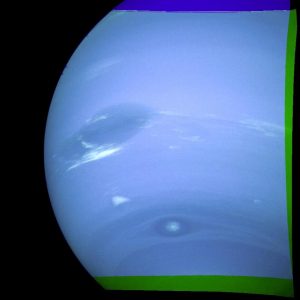
Neptune's Dark Spot captured in 1989, accompanied by the Dark Spot 2 to its south. https://www.jpl.nasa.gov/spaceimages/details.php?id=PIA00049 Credit: NASA
Neptune’s Great Dark Spot is a huge spinning storm about the size of the earth that has winds with speeds estimated up to 223 miles per hour, these winds are similar to the wind speeds on Jupiter.² Since the Voyager 2 Spacecraft did a flyby in 1989, observing the first two mysterious spots on Neptune, the Hubble Space Telescope has discovered an additional four spots, realizing the spots disappear after a certain amount of time with new spots arising. Observations have been made that the Great Dark Spots on Neptune do not last very long compared to the size of the planet. Neptune’s Great Dark Spots are still being further observed to answer the unknown questions about the discovery and disappearance of the spots. Neptune’s Great Dark Spot is a more recent discovery compared to Jupiter’s Great Red Spot that has been observed continuously since the 1800s. The arising question about Neptune and its Great Dark Spots is if these spots are actually disappearing or are the characteristics of them changing causing them to increase or decrease in size.
Initial Discovery
The first discovery of the great dark spot was in 1989 when NASA's Voyager 2 spacecraft flew by Neptune. Since Neptune is about 4.5 billion km from the sun, it was expected that Neptune is dark, dormant, and frigid. Astronomers were shocked after seeing the Voyager images. Among the images that surprised them was an image of the great dark spot on Neptune.
Since Neptune is a gas giant planet, its atmosphere undergoes differential rotation. As for the wide equatorial zone, it rotates with a period of about 18 hours. On the other hand, the rotation period around the polar regions is 12 hours. This differential rotation results in strong latitudinal wind shear and violent storms. In 1989, three storms were spotted by the Voyager 2 space probe, and they were named based on their appearances.²
The Great Dark Spot was the first storm to be spotted. It was a massive anticyclonic storm measuring 13,000 x 6,600 km and resembling the Great Red Spot of Jupiter. Another storm was a white cloud group located farther south than the Great Dark Spot. It was called the Scooter. The second-most-intense storm observed during the 1989 encounter was the Small Dark Spot, a southern cyclonic storm. It was initially completely dark; but a bright core developed when Voyager 2 approached the planet and could be seen in most of the highest-resolution images.³
On Nov. 2, 1994, when the Hubble Space Telescope took sharp images of Neptune, the Great Dark Spot and the Small Dark Spot disappeared, and new dark spots had appeared in the northern atmosphere of Neptune. It was certainly a surprise compared to Jupiter's Great Red Spot, which presumably had been there for more than a hundred years.⁴
Simon and her colleagues discovered small, bright white clouds while they were analyzing Hubble images of a smaller dark spot that appeared in 2015. In the region of this small, bright white clouds appeared a new Great Dark Spot nearly identical in size and shape to the Great Dark Spot that appeared in 1989. "We were so busy tracking this smaller storm from 2015, that we weren't necessarily expecting to see another big one so soon," Simon said.⁴
Characteristics
Being one in a series of storms on Neptune, the Great Dark Spot (GDS-89) was the first sighting of said storms, which provoked a series of observations into Neptune's atmosphere and the workings of its climate. The other storms that circulated around Neptune were of similar interest to scientists: GDS-94, SDS (Small Dark Spot), The Scooter, etc. These storms seemed to echo one another in their general composition, but there were telling differences between a few, while others were more comparable to sister storms.
The GDS-89 was an anticyclonic counter clockwise storm on Neptune’s southern hemisphere that was as large as the Earth itself, a result of Neptune's winds moving opposite to the rotation of the planet itself.⁵ These winds regularly move opposite to the planet's rotation, causing Neptune's extreme climate, however, the SDS was discovered to have a cyclonic clockwise direction and was indicative that these storms can vary from one another in a multitude of different ways.⁶ All dark spots are extreme storms, but not all dark spots are the same. The GDS-89 was 13,000 x 6,600 kilometers in size, with brighter clouds that float above the darker areas of the great dark spots.7 It had a wavelength of 480 nm and a rotation period of 18.3 hours and had a bright companion near the equator that kept its placement for nearly a month.¹ A thin veil fills the interior of the GDS-89 as well. The winds that categorize these storms go at about approximately 328 feet a second, this being a key factor in why the great dark spots of Neptune are so fascinating: Neptune has the fastest winds on any planet in our system despite Neptune's energy being so small in comparison.⁸
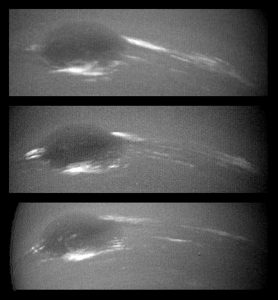
Changes in Neptune's Great Dark Spot, taken in 1996
https://www.jpl.nasa.gov/spaceimages/details.php?id=PIA00047 Credit: NASA
High altitude, infrared-bright clouds are composed of methane ice crystals and seemingly are companions to these dark spot storms, floating above them near the tropopause while the dark spots are thought to occur in the troposphere at low altitudes. Meanwhile, these darker spots are thought to be a hole in the cloud deck of Neptune.⁹ Computer based models of Neptune's atmosphere have yielded more important information about Neptune's storms, showing the deeper that the storm is, the brighter these high-altitude clouds are.¹⁰
The GDS-94 differs slightly from the GDS-89, however, it gave scientists further information on these great dark spots and their composition. Founded on August 24th, 1994, an indication of strong winds was present due to bands that drifted around the spot, meanwhile in the inner parts of the spot there seemed to be structures that, to the scientists, showed equal indications of a central rotation.¹¹ Compared to the GDS-89, GDS-94 had a rotation period of 18.4 hours with a wavelength of 467 nm.¹
There was another important comparison that was made to further the understanding of Neptune's storms. A difference was apparent between the GRS (Great Red Spot) of Jupiter and the GDS-89 of Neptune: The period of the GRS matches the planet's radio rotation rate of approximately 4 m/s westward, while the GDS-89 had a period of 18.3 hours westward compared to the interior period of 16.11 hours.¹² This communicates to us the possibility of the GDS-89 being deep while the GRS is much shallower. Further studies by Simon, Wong, and Hsu of Neptune's atmosphere also indicates that these high-altitude clouds appear two years before the great dark spot's formation and that when these great dark spots do make themselves known, the brightness of these clouds lower to some degree points to the idea that these dark spots may be deeper in the atmosphere.¹³
Disappearing Dark Spots
The dark spots observed on Neptune are unique phenomena that are not fully understood by scientists. Throughout the years, astronomers have sent out various missions to try and gain some understanding on these spots, and why exactly they occur. One of the first spots to be seen after the 1989 spot observed by NASA’S Voyager 2, was in 1994 and observed along with it was a companion cloud.¹⁴ Another spot had been noted in 1996, this one however was not viewed with a companion cloud.¹⁴
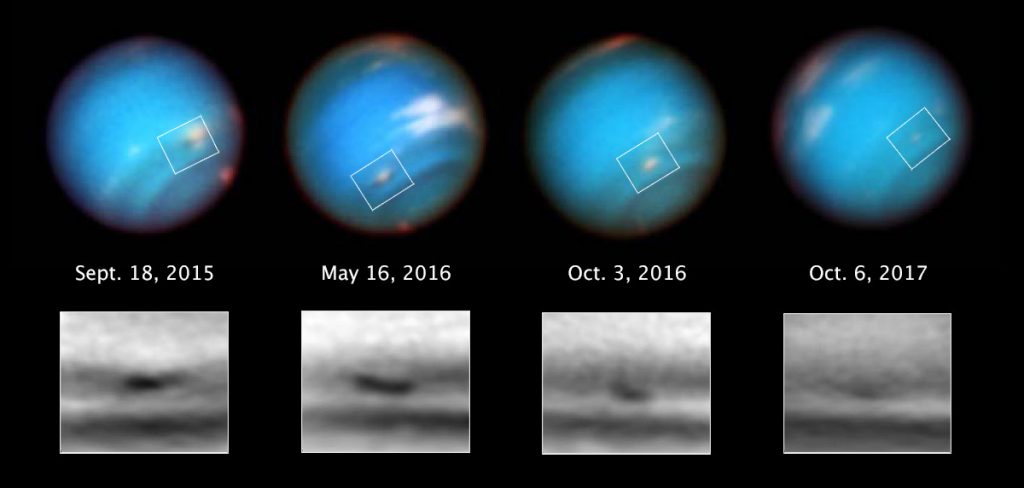
SDS-2015 (Southern Dark Spot that was discovered in 2015). These photos were taken over the period of two years using Hubble’s Wide Field Camera 3. https://www.spacetelescope.org/images/potw1808a/
After further observations, the two spots observed from 1994-1996 showed no signs of latitudinal drift. A statement from Sromovsky et al., says that A way of explaining the situation is that there are differences in temperatures and wind, depending on the location of the storm.¹⁴ Those differences change the vorticity gradient that allow dark spots to gain stability against any kind of drifting.¹⁴ They also stated that the movement of the 1989 GDS in the direction of the equator was most likely the reason behind its disappearance before autumn of 1990.¹⁴ This suggests that the ‘newer’ spots possibly decayed for other reasons, as none of them exhibited any kind of latitudinal drift. That being said, from 1996-1998 both of the spots on the Northern hemisphere of Neptune had vanished, but the companion cloud observed earlier was still visible.
Are The Spots Really Disappearing?
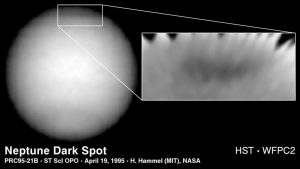
New Dark Spot on Neptune, captured in 1995. https://www.jpl.nasa.gov/spaceimages/details.php?id=PIA01286 Credit: NASA
Some scientists believe that the spots do not all initially disappear, but rather, migrate across Neptune either before, or instead of dissipating. In a statement given by Jennifer Leman while observing a dark spot on Neptune, over the course of roughly 20 hours, the storm have moved west at a rate slightly slower than Neptune’s usual fast paced winds.¹⁵ Leman also described what possibly happens when a storm begins to disappear, when she said the storms usually stay between westward and eastward-blowing wind gusts in the higher areas on Neptune’s surface before stronger winds separate them from each other.¹⁵ As a result of the high-speed winds on Neptune’s surface, the strong gusts cause the dark spots to be pulled apart. Since technology has developed, it is now known that eventually, all dark spots disappear.
What is the “Lifespan” of A Dark Spot?
Each storm seems to be unique from one another, so scientists still are not sure on what exactly causes them to dissipate. What they are sure about, is that each spot has a lifespan. Leman said that they estimate that new dark spots appear on Neptune roughly every four to six years. It is possible for a storm to last up to six years, though two years are usually where lifespan ends.¹⁵ To continue research that focused on Neptune’s storms, and why exactly they appear/disappear, The Outer Planet Atmosphere Legacy (OPAL) Project was created. The project was also put together in hopes of gaining a better understanding as to why the storms form/move the way they do.
In Conclusion...
Neptune’s evolution of its great dark spots is of significant importance to our understanding of Neptune’s climate and atmospheric composition. The great dark spots and the mystery of their appearances and disappearances are clues that instigated scientists to take a closer look at this large planet and reanimate the atmosphere of Neptune in computer models to further understand how these great dark spots worked. Because of the readily available data that we have compiled over the years of watching these great dark spots, we now have a better understanding of how and why these great dark spots appear and disappear. Appearances and disappearances of these great dark spots are possibly due to Neptune’s high-speed winds pulling them apart, although this is still maintained as a possibility rather than an ultimatum of the end of a great dark spot’s lifespan. It is still a topic of general mystery. While scientists have discovered more about Neptune’s atmosphere, more specifically, the formation and contents of these storms, the question still remains as to what exactly causes these great storms to eventually come to an end.
References
¹ H.B. Hammel, G.W. Lockwood, J.R. Mills, and C.D. Barnet, Hubble Space Telescope Imaging of Neptune's Cloud Structure in 1994. Science. 268, 1740 (1995).
² Cool Cosmos. What is the Great Dark Spot? http://coolcosmos.ipac.caltech.edu/ask/149-What-is-the-Great-Dark-Spot- (Accessed March 2020).
³ M. Williams. The gas (and ice) giant Neptune https://phys.org/news/2015-09-gas-ice-giant-neptune.html (Accessed March 2020).
⁴ American Geophysical Union. Hubble captures birth of giant storm on Neptune. https://www.sciencedaily.com/releases/2019/03/190325120355.htm (Accessed March 2020).
⁵ Burgess, Eric, Far Encounter: The Neptune System. https://archive.org/details/farencounternept00burg (Accessed March 2020).
⁶ Jet Propulsion Laboratory. PIA02245: Neptune’s Dark Spot (D2) at High Resolution. https://photojournal.jpl.nasa.gov/catalog/PIA02245 (Accessed March 2020).
⁷ Jet Propulsion Laboratory. PIA00064: Neptune’s Dark Spot (D2) at High Resolution. https://photojournal.jpl.nasa.gov/catalog/PIA00064 (Accessed March 2020).
⁸ V. E. Suomi, S. S. Limaye, and D. R. Johnson, Science 255, 929 (1991).
⁹ Nasa. The Great Dark Spot. https://pds.jpl.nasa.gov/planets/captions/neptune/gdspot2.htm (Accessed March 2020)
¹⁰ S.G Gibbard, I de Pater, H.G Roe, S Martin, B.A Macintosh, and C.E Max, Icarus 166, Iss. 2, 374 (2000).
¹¹ Nasa. Small Dark Spot. https://pds.jpl.nasa.gov/planets/captions/neptune/ldspot.htm
¹² L. M. Polvani, J. Wisdom, E. DeJong, and A. P. Ingersoll, Science 249, 4975 (1990).
¹³ A. A. Simon, M. H. Wong, and A. I. Hsu, Geophysical Research Letters 46, Iss. 6, 3113 (2019).
¹⁴ L.A. Sromovsky, P.M. Fry, T.E. Dowling, and K.H. Baines, in Bull. Am. Astron. Soc., (DPS Meeting #32, 2000), p. 1005.
¹⁵ Jennifer Leman, Hubble Tracks the Lifecycle of Giant Storms on Neptune. http://www.nasa.gov/feature/goddard/2019/neptune-storms (Accessed March 2020).